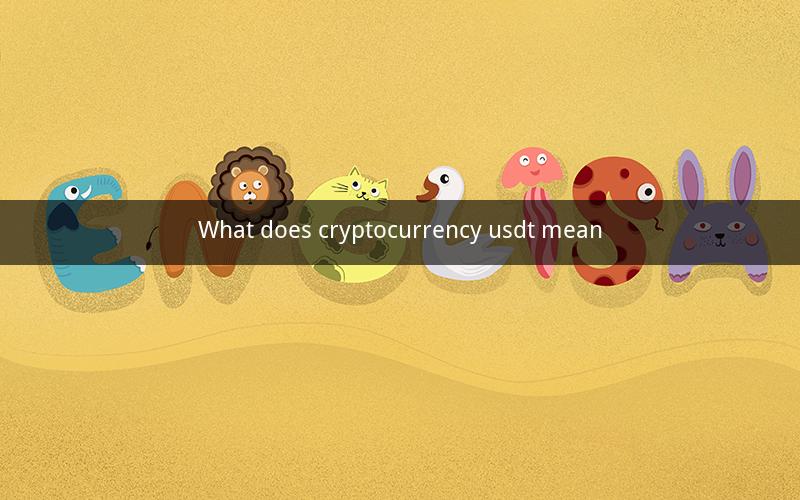
Table of Contents
1. Understanding Cryptocurrency
2. The Concept of USDT
3. The History of USDT
4. How USDT Works
5. Benefits of Using USDT
6. Risks and Concerns with USDT
7. The Future of USDT
8. USDT vs. Other Cryptocurrencies
9. Conclusion
1. Understanding Cryptocurrency
Cryptocurrency is a digital or virtual currency that uses cryptography for security. It operates independently of a central bank and is based on a decentralized system, typically using blockchain technology. Cryptocurrencies can be used to buy goods and services, make investments, or simply hold as an asset.
2. The Concept of USDT
USDT, also known as Tether, is a type of cryptocurrency that aims to bridge the gap between the traditional financial system and the decentralized world of cryptocurrencies. It is a stablecoin, which means it aims to maintain a stable value compared to a fiat currency, in this case, the US dollar.
3. The History of USDT
USDT was launched in July 2015 by Tether Limited, a company based in Hong Kong. The idea behind USDT was to create a cryptocurrency that could be used as a medium of exchange, store of value, and a bridge between the fiat and digital worlds.
4. How USDT Works
USDT operates on the Omni Layer Protocol, a protocol built on top of the Bitcoin blockchain. When a user wants to purchase USDT, they send Bitcoin to a designated address. In return, they receive USDT in their wallet. Similarly, when a user wants to convert USDT back to Bitcoin, they send USDT to a designated address and receive Bitcoin in return.
5. Benefits of Using USDT
One of the main benefits of using USDT is its stability. Unlike other cryptocurrencies, which can be highly volatile, USDT aims to maintain a value of $1 per coin. This makes it an attractive option for those looking to store value or use it as a medium of exchange. Additionally, USDT can be used to avoid the volatility and transaction fees associated with other cryptocurrencies.
6. Risks and Concerns with USDT
Despite its benefits, there are concerns and risks associated with USDT. One of the main concerns is the question of whether Tether Limited holds enough fiat currency reserves to back each USDT token. There have been reports suggesting that Tether Limited may not have enough reserves to support the total supply of USDT in circulation.
Another concern is the potential for manipulation and market manipulation, as Tether Limited has control over the creation and destruction of USDT tokens.
7. The Future of USDT
The future of USDT remains uncertain. As the cryptocurrency market continues to evolve, the role of stablecoins like USDT may become more significant. However, there are challenges to be addressed, such as ensuring the transparency of Tether Limited's reserves and addressing concerns about market manipulation.
8. USDT vs. Other Cryptocurrencies
USDT is different from other cryptocurrencies in several ways. First, it is a stablecoin, whereas most cryptocurrencies are volatile. Second, USDT is backed by fiat currency, whereas other cryptocurrencies are not. Finally, USDT is a utility token, designed to be used as a medium of exchange, while other cryptocurrencies may have different use cases.
9. Conclusion
USDT is a unique cryptocurrency that aims to provide stability and bridge the gap between traditional and decentralized finance. While there are risks and concerns associated with USDT, it remains an important player in the cryptocurrency market. The future of USDT will depend on the ability of Tether Limited to address these concerns and maintain the stability of the USDT ecosystem.
10 Questions and Answers
Q1: What is the difference between USDT and other cryptocurrencies?
A1: USDT is a stablecoin, aiming to maintain a value of $1 per coin, whereas most cryptocurrencies are volatile. USDT is also backed by fiat currency, whereas other cryptocurrencies are not.
Q2: Is USDT a secure investment?
A2: While USDT aims to be a stable investment, it is not without risks. Concerns about Tether Limited's reserves and the potential for market manipulation need to be considered.
Q3: Can I use USDT to pay for goods and services?
A3: Yes, USDT can be used to pay for goods and services, especially those that accept cryptocurrencies.
Q4: Is USDT legal in all countries?
A4: The legality of USDT varies by country. It is important to check the regulations in your specific jurisdiction.
Q5: Can I trade USDT on a cryptocurrency exchange?
A5: Yes, USDT can be traded on many cryptocurrency exchanges, along with other cryptocurrencies.
Q6: What is the difference between USDT and other stablecoins?
A6: USDT is one of the most popular stablecoins, but there are other stablecoins like DAI and USD Coin that use different technologies and backing mechanisms.
Q7: Can USDT be used for international transactions?
A7: Yes, USDT can be used for international transactions, as it is a stable and widely accepted cryptocurrency.
Q8: Is USDT a good long-term investment?
A8: The potential for long-term investment depends on the stability of Tether Limited's reserves and the overall cryptocurrency market.
Q9: Can I mine USDT?
A9: No, USDT cannot be mined. It is created and destroyed by Tether Limited.
Q10: Is USDT a good alternative to fiat currency?
A10: USDT can be a good alternative to fiat currency for those looking to participate in the cryptocurrency market without the volatility of other cryptocurrencies.